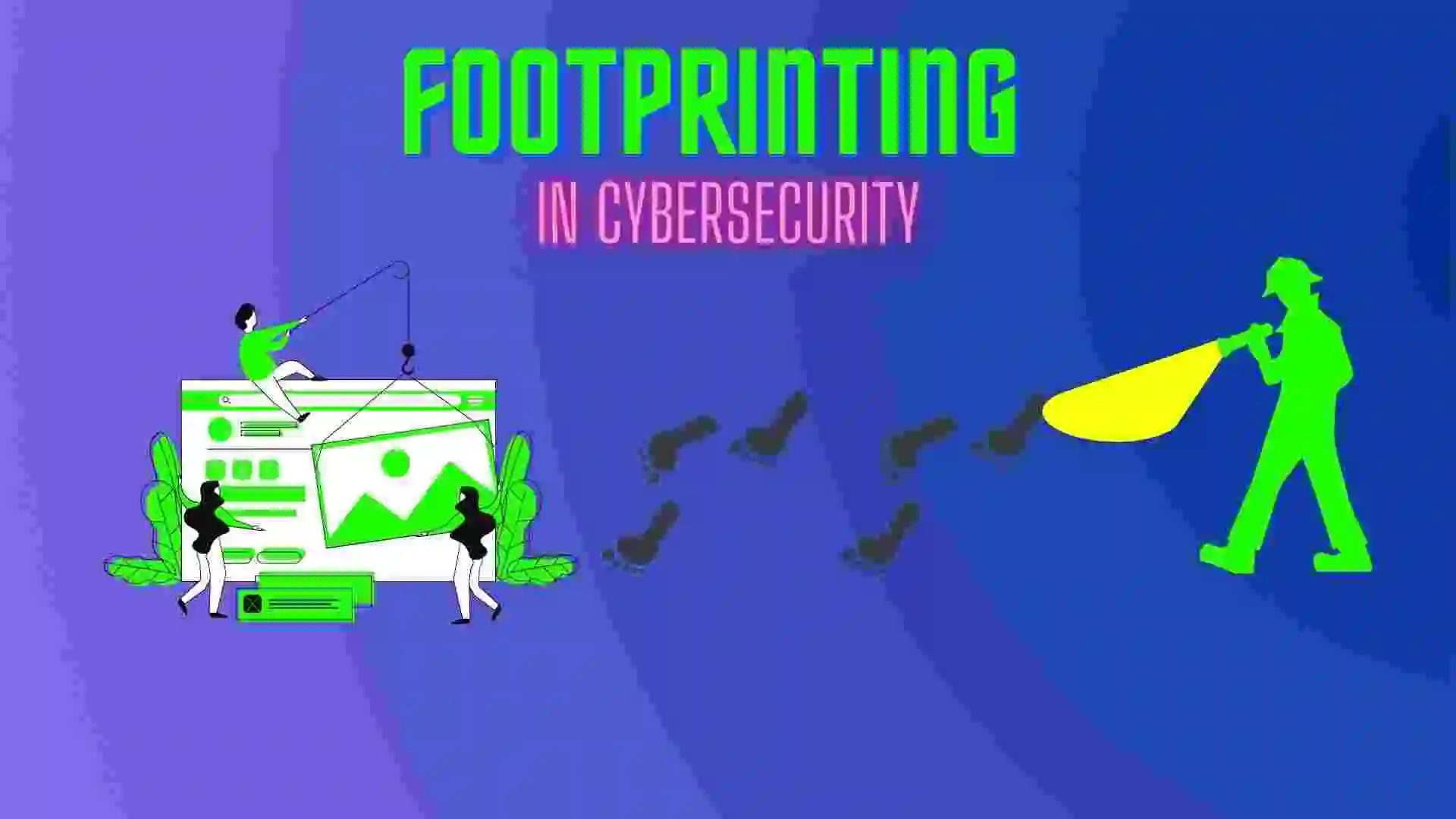In this blog, I will explain Footprinting which is one of the first phases of cyber security. So lets us see why it is considered to be one of the most important steps in Cyber Security.
Table of Contents
- Introduction to FootPrinting
- Start with FootPrinting
- Classification of FootPrinting
- Purpose
- Objectives
- FootPrinting Threats
- Counter Measures
- Tools for FootPrinting
- Conclusion
- FAQ
Introduction to FootPrinting
Footprinting, also known as reconnaissance, is the process of gathering information about a target system or network with the goal of discovering potential vulnerabilities or weaknesses. In the context of cybersecurity, footprinting is an essential step in the process of conducting a security assessment or penetration testing.
The goal of footprinting is to obtain as much information as possible about a target system or network without being detected. This information can include IP addresses, network topologies, operating systems, open ports, software versions, and user accounts.
It is important in cybersecurity because it allows security professionals to identify potential weaknesses in a system or network before an attacker can exploit them. By understanding how a system or network is configured and what vulnerabilities exist, security professionals can develop strategies for mitigating those vulnerabilities and protecting the system from attacks.
Start with FootPrinting
Reconnaissance, which plays a significant role in the first hacking activities, is similar to footprinting. It is essentially a passive footprinting operation where we gather data during penetration testing regarding the target’s possible weaknesses and vulnerabilities.
Finding the location and the goal of an incursion are the first steps in the footprinting process. After the ethical hackers have located a specific target, they attempt to learn as much as possible about the network and company via non-intrusive techniques, such as gaining access to the company’s staff database, website, or biography.
To find security flaws and further ethical hacking objectives, ethical hackers gather this data and launch social engineering efforts.
Classification of FootPrinting
In Ethical Hacking, FootPrinting is classified into two types:
- Active FootPrinting
- Passive FootPrinting
A) Active FootPrinting
Active footprinting refers to the process of gathering information about a target system or network by directly interacting with it using various tools and techniques.
It involves performing actions such as scanning ports, sending probes, and conducting vulnerability assessments to gather information about the target.
The intrusion detection system for that particular target is activated (IDS). To effectively evade discovery, it takes a certain amount of ingenuity and subtlety.
The goal of active footprinting is to identify vulnerabilities in the target system or network, as well as potential entry points for attackers. However, it’s important to note that active footprinting can also be detected by security measures put in place by the target organization, and in some cases may even be illegal without prior permission or authorization. Therefore, it should only be carried out with caution and in compliance with ethical and legal guidelines.
Active Foot-printing techniques include:
- Querying the target’s exposed name servers.
- Extracting data from exposed files and documents.
- Using internet snooping and mirroring techniques to get website Information.
- Gathering Information using E-mails.
- By Performing whois Operation.
- Extracting Domain Name Server (DNS) information.
B) Passive FootPrinting
Passive footprinting is a type of reconnaissance or information-gathering technique used in cybersecurity to obtain information about a target system or organization without directly engaging with it. It involves using publicly available sources of information such as search engines, social media, and online directories to gather data about the target.
Passive footprinting techniques can include:
- Search engine queries: Use search engines like Google, Bing, or DuckDuckGo to search for information about the target such as websites, social media accounts, employees, etc.
- Social media analysis: Examining the target’s social media accounts to gather information about their activities, interests, and connections.
- Domain name system (DNS) lookup: Looking up the target’s domain name to obtain information about its IP address, hosting provider, and other related information.
- WHOIS lookup: Examining the WHOIS database to gather information about the target’s domain name ownership, contact information, and registration details.
- Email analysis: Searching for emails related to the target or from the target’s domain to gather information about its employees, partners, and other contacts.
- Network mapping: Using tools like Nmap to scan the target’s network and obtain information about its systems, services, and vulnerabilities.
Passive footprinting is considered a non-intrusive and low-risk approach to reconnaissance, as it does not involve directly probing or attacking the target’s systems. However, it can provide valuable information to an attacker that can be used in subsequent attacks.
Purpose
Footprinting techniques in ethical hacking assist companies in locating and securing IT infrastructure before a danger takes advantage of a weakness. Users can also create a database of known security gaps and weaknesses.
By analysis of information obtained about the deployed firewall, security configuration, and other information, footprinting also aids organizations in better understanding their present security level. Users may simply update this list on a regular basis and use it as a resource for any security assessments.
It will be easier to cover all the reliable servers, routers, and other network topologies if you create a network map. By limiting the attack surface to a certain set of systems, users can identify a lowered attack surface.
Objectives
The main objectives of footprinting include:
- Gathering information about the target: It helps in identifying the target’s IP addresses, network topology, operating systems, and other system information.
- Identifying vulnerabilities: By gathering information about the target, attackers can identify potential vulnerabilities and weaknesses in the system that can be exploited.
- Developing attack strategies: With the information gathered during the footprinting process, attackers can develop effective attack strategies tailored to the target system.
- Planning social engineering attacks: Footprinting can also provide information about employees, organizational structure, and other sensitive information that can be used in social engineering attacks.
- Enhancing security: Footprinting can be used by security professionals to identify vulnerabilities in their own systems and take appropriate steps to address them before attackers can exploit them.
FootPrinting Threats
The following are the different possible threats through footprinting:
A) Network and System Attacks:
An offender uses footprints to facilitate network and system intrusions. Attackers will obtain information through this on the operating system running on the computer, the system setup for the particular target organization, and other things. By the use of this information, malicious parties can identify weaknesses in the target system and take advantage of them. Attackers can then seize control of the entire network or just a single target system.
B) Social Engineering:
Hackers get information through persuasion and other ways without utilizing any intrusion techniques, either indirectly or directly. Employees who are ignorant of the hacker’s aim might be used to collect sensitive and important information.
C) Privacy Loss:
Using footprinting techniques, hackers can get access to the organization’s networks and systems and even acquire privileges and rights up to the admin levels, threatening the security and threatening both the employees and the organization’s collective privacy.
D) Business Loss:
Organizations like various eCommerce websites and online enterprises, banking institutions, and businesses with a financial connection are all significantly impacted by footprinting. Every year, malevolent hacker assaults result in financial damages.
E) Information Leakage:
Each company is at risk of data leaking. Once an attacker obtains sensitive information from an organization, they will set up an attack to either exploit the information to cause harm or to gain money off of it.
Counter Measures
Countermeasures for footprinting can include:
- Use of firewalls and intrusion detection/prevention systems to monitor network traffic and block any attempts to scan or gather information about the network.
- Implementing strong authentication and access controls to prevent unauthorized access to sensitive information.
- Regularly monitor and audit network logs to identify any suspicious activity.
- Implementing strong password policies, including mandatory password changes and the use of complex passwords.
- Conducting regular vulnerability assessments and penetration testing to identify and address potential vulnerabilities before they can be exploited.
- Limiting the amount of information that is publicly available about the organization and its systems.
- Educating employees on the risks of social engineering and phishing attacks, as these are often used to gather information about a target organization.
- Regularly updating software and hardware to ensure that known vulnerabilities are addressed and patched.
- Use of encrypted communication channels, such as VPNs, to protect sensitive information as it travels over the network.
- Conducting regular security awareness training for employees to ensure that they understand the importance of protecting sensitive information and are aware of potential risks and threats.
Tools for FootPrinting
Some Important Tools for FootPrinting are as follows:
- WHOIS FootPrinting.
- Traceroute Tool.
- Nmap Tool.
- Sam Spade.
- NSlookup Tool.
- SuperScan.
- Nessus.
- DNS Enumerator.
I will explain each tool in a detailed manner. So, please subscribe to our blog.
Conclusion
However, it’s worth noting that while footprinting can be a valuable tool for cybersecurity, it can also be used by attackers to gather information for nefarious purposes. For this reason, it’s important for organizations to have strong security measures in place to prevent unauthorized access to their systems and networks, and to regularly conduct security assessments to identify and address potential vulnerabilities.
FAQ
Footprinting, also known as reconnaissance, is the process of gathering information about a target system or network with the goal of discovering potential vulnerabilities or weaknesses. In the context of cybersecurity, footprinting is an essential step in the process of conducting a security assessment or penetration testing.
The goal of it is to obtain as much information as possible about a target system or network without being detected. This information can include IP addresses, network topologies, operating systems, open ports, software versions, and user accounts.
There are two types of FootPrinting:
1) Active FootPrinting
2) Passive FootPrinting
Active FootPrinting:
Active footprinting refers to the process of gathering information about a target system or network by directly interacting with it using various tools and techniques.
It involves performing actions such as scanning ports, sending probes, and conducting vulnerability assessments to gather information about the target.
B) Passive FootPrinting
Passive footprinting is a type of reconnaissance or information-gathering technique used in cybersecurity to obtain information about a target system or organization without directly engaging with it. It involves using publicly available sources of information such as search engines, social media, and online directories to gather data about the target.
WHOIS FootPrinting.
Traceroute Tool.
Nmap Tool.
Sam Spade.
NSlookup Tool.
SuperScan.
Nessus.
DNS Enumerator.




